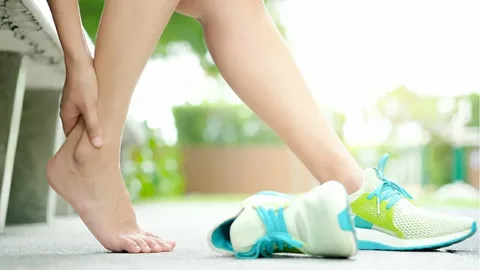Do you suffer from plantar fasciitis? Are you looking for shoes that provide support and cushioning to alleviate your discomfort? If so, you’ve come to the right place! In this blog post, we’ll discuss the tips to help you choose the best sneakers for plantar fasciitis. From fit and cushioning to arch support and stability, we’ll provide the information you need to make an informed decision. You can enjoy greater comfort and reduce your risk of further pain or discomfort with the right shoes.
Understanding Plantar Fasciitis
Plantar fasciitis is a common condition that causes pain in the heel and bottom of the foot. It occurs when the thick band of tissue that runs along the bottom of the foot, called the plantar fascia, becomes inflamed. This can happen due to excessive pressure on the foot, often from wearing poorly fitting shoes. People who suffer from plantar fasciitis often experience pain in the morning, as the tissue becomes stiff after being inactive all night. This pain can also be felt after long periods of standing or walking. It is essential to choose shoes that support and protect the foot to alleviate the symptoms of plantar fasciitis.
The condition can worsen without proper footwear, leading to chronic pain and even immobility. Individuals with plantar fasciitis can reduce pain and improve their quality of life by selecting shoes that provide the appropriate support and cushioning. To make the right choice when shopping for shoes, it is essential to know the features to look for and which styles to avoid. In the following sections, we will discuss what makes a good shoe for plantar fasciitis and provide tips on choosing the best shoes for this condition.
Features of Good Shoes for Plantar Fasciitis
When it comes to choosing shoes for plantar fasciitis, there are several features that you need to consider. Plantar fasciitis is a common condition where the tissue on the bottom of your foot becomes inflamed, leading to heel pain and stiffness. Wearing the right shoes can make a big difference in alleviating these symptoms and providing the support and comfort you need to stay active and on your feet. You need to look for shoes that have good arch support. Shoes with flat soles can put more pressure on your feet, leading to more discomfort and pain. Instead, shoes with good arch support help to distribute your weight more evenly across your feet, reducing the amount of strain on your plantar fascia.
Another feature to consider is a broad and roomy toe box. Too narrow shoes can cramp your toes, leading to discomfort and even exacerbating your plantar fasciitis symptoms. A wider toe box allows your toes to spread naturally and reduces the pressure on your foot. Stability is crucial when it comes to shoes for plantar fasciitis. Shoes with a firm heel counter and good overall support help stabilize your feet and reduce any excessive motion that could exacerbate your plantar fasciitis.
Comfort Over Style
When choosing shoes for plantar fasciitis, it’s essential to prioritize comfort over style. While you may want to look fashionable, your priority should be finding shoes that provide the proper support and cushioning to relieve your foot pain. Shoes prioritizing style over comfort can exacerbate plantar fasciitis symptoms, causing more pain and discomfort. High heels and shoes with thin soles, for instance, can increase pressure on your heel, leading to plantar fascia inflammation.
Instead, opt for shoes with a supportive, cushioned sole and ample arch support. A sturdy, supportive heel is also essential to help distribute your weight evenly across your foot. Choosing shoes that offer a combination of these features will ensure that your feet feel comfortable, even after extended periods of walking or standing. Remember that comfort doesn’t have to mean compromising on style. Plenty of stylish shoes are available that prioritize comfort, with designs that cater to your style preferences. With so many options available, you’re sure to find shoes that provide the support you need while allowing you to express your style.
Essential Features for Best Sneakers for Plantar Fasciitis
When it comes to choosing the best sneakers for plantar fasciitis, there are a few essential features that you should keep in mind. These features can make all the difference in providing the necessary support and comfort that your feet need to alleviate the pain associated with this condition. It’s important to choose sneakers that have a firm and supportive heel counter. The heel counter is the back part of the shoe that wraps around your heel. A firm heel counter provides stability and support to your heel, which can help reduce the strain on your plantar fascia.
Look for sneakers that have good arch support. Arch support helps distribute your weight evenly across your feet, reducing the pressure on your plantar fascia. This feature can be especially beneficial for people with high arches. Opt for sneakers that have a thick, shock-absorbing sole. A thick sole can help cushion your feet and absorb the impact of each step, reducing the strain on your plantar fascia.
Look For a Wide and Roomy Toe Box
When choosing shoes for plantar fasciitis, it’s essential to consider the shape and size of your feet. A common issue for those with plantar fasciitis is tightness and toe discomfort. This is why a wide and roomy toe box is crucial. A narrow toe box can cause rubbing, squeezing, and cramping of the toes, exacerbating plantar fasciitis symptoms. On the other hand, a roomy toe box allows for natural movement of the toes and prevents unnecessary pressure and friction.
Aim for a shoe with ample space for your toes to wiggle freely without feeling restricted. Additionally, consider the shape of the toe box. Rounded toe boxes are more accommodating than pointed ones, providing more space for the toes. Remember that a shoe may feel comfortable in the store but may feel constricted after extended periods of wear. Make sure to test the boots out for at least a few hours before making a final decision.
Cushioning Helps With Impact
Cushioning is one of the most essential when choosing shoes for plantar fasciitis. This is because cushioning helps absorb the impact of each step and reduces the pressure on the feet. When you have plantar fasciitis, your feet are more susceptible to impact-related injuries. Walking or standing on hard surfaces for prolonged periods can lead to micro-tears in the plantar fascia ligament, causing pain and inflammation. To avoid this, look for shoes with ample cushioning to absorb the shock of each step.
Cushioning can be made of various materials, such as gel, foam, or air pockets. The level of cushioning you need depends on your level of discomfort. Those with mild plantar fasciitis may only require moderate cushioning, while those with more severe cases may need maximum cushioning. It’s important to note that too much cushioning can also be detrimental, as it can reduce stability and cause the foot to roll inward. This is why it’s essential to balance cushioning and strength when choosing shoes for plantar fasciitis.
Importance of Proper Fit
When choosing shoes for plantar fasciitis, proper fit is critical. Wearing shoes that are too tight or loose can cause additional strain on the feet, aggravating the plantar fascia. On the other hand, shoes that fit well provide the necessary support and cushioning to alleviate the pain associated with plantar fasciitis. To ensure proper fit, measuring your feet before buying shoes is essential. Use a tape measure to determine the length and width of your feet, and consult the sizing charts provided by shoe manufacturers. Remember that sizing can vary between brands, so it’s best to try on shoes before purchasing them.
When trying on shoes, please pay attention to how they feel on your feet. Ensure there is enough room for your toes to move around comfortably and that the shoes do not pinch or rub against any part of your foot. Walk around in the shoes to feel their stability and cushioning. If you have plantar fasciitis, consider visiting a specialist or podiatrist who can recommend shoes that best suit your needs. They may also suggest inserts or custom orthotics to provide additional support and alleviate pain.
FAQs
What causes plantar fasciitis?
Plantar fasciitis is often caused by repeated strain on the plantar fascia, the thick band of tissue that runs across the bottom of your foot and connects your heel bone to your toes. Factors that can contribute to the development of plantar fasciitis include:
- Wearing shoes with inadequate support.
- Standing or walking for extended periods on hard surfaces.
- High-impact activities like running and jumping.
Can wearing the wrong shoes make plantar fasciitis worse?
Wear shoes that provide insufficient support or cushioning can worsen plantar fasciitis symptoms. Shoes with too much flexibility or too tight in the toe box can also cause additional discomfort.
Are high heels bad for plantar fasciitis?
Yes, high heels can exacerbate plantar fasciitis symptoms because they put extra pressure on the plantar fascia. If you must wear heels, opt for those with a lower heel height and adequate support.
Can inserts or orthotics help with plantar fasciitis?
Yes, inserts or orthotics can help provide extra support and cushioning to the feet, which can alleviate symptoms of plantar fasciitis. However, choosing the right inserts or orthotics is essential and ensuring they fit correctly in your shoes.
The Bottom Line
When choosing shoes for plantar fasciitis, the bottom line is finding the right balance between comfort and support. It’s important to understand the condition and how certain features in shoes can help alleviate the symptoms. Arch support and stability are crucial factors to look for in shoes for plantar fasciitis. A wide and roomy toe box also helps reduce pressure on the toes and forefoot. Cushioning can help absorb impact and reduce pain. While comfort should be a top priority, it’s also important to consider the fit of the shoe. Properly fitting shoes can prevent further damage and promote healing.
| Other Good Articles to Read |
| Niche Blogs Connect |
| Blogs 97 |
| Blog Stitution |
| Blogs Unplugged |
| Blogs Cotch Rouge |
| Blog Signatr |
| Blog Sintonias |
| Blog Zilla |
| Consumer Forums |
| G Blogs |
| Too Blog |



